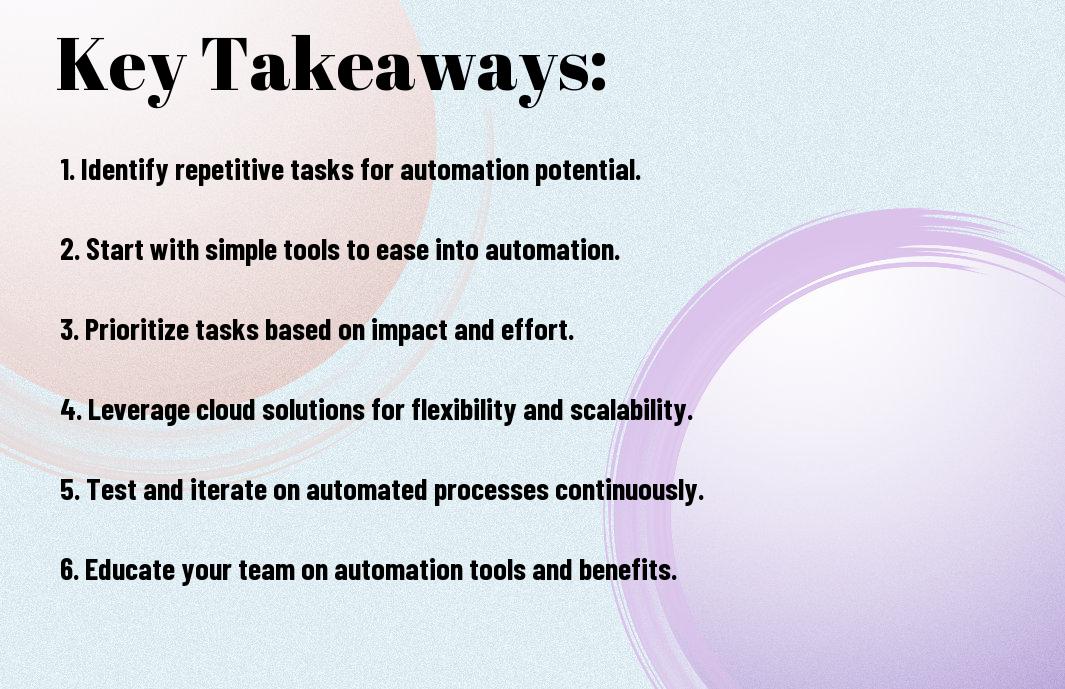With the right strategies, you can streamline your operations and enhance efficiency through automation. This blog post will provide you with 17 actionable tips specifically tailored for beginners in the business sector. From simple tasks to more advanced processes, you’ll learn how to implement effective automation techniques to save time and resources. For more insights, check out these 20 Effective Ways to Automate and Grow Your Business.
Key Takeaways:
- Begin with identifying repetitive tasks within your business to prioritize automation efforts.
- Leverage cloud-based tools for flexibility and scalability in your automation strategies.
- Integrate automation gradually to minimize disruptions and ensure smooth transitions.
- Utilize analytics to monitor the performance of automated processes and make necessary adjustments.
- Invest time in training your team to use automated tools effectively, enhancing overall productivity.

Understanding Automation
To successfully navigate the world of business, it’s crucial to understand automation. This process involves using technology to perform tasks that were traditionally done by humans, allowing you to streamline processes, improve efficiency, and enhance productivity. By grasping how automation operates, you can make informed decisions that will positively impact your business operations.
Definition of Automation
Behind the term “automation” lies the concept of utilizing technology and software to execute tasks with minimal human intervention. This can include anything from managing data inputs to automating customer communication, ultimately enhancing operational efficiency and freeing up your time for more strategic initiatives.
Benefits of Automation for Beginners
Around the world of business automation, you’ll discover numerous advantages, particularly for those just starting out. Simplifying repetitive tasks can help you save precious time, reduce the likelihood of errors, and enable you to focus on core activities that drive growth and innovation.
Hence, embracing automation as a beginner can lead to substantial improvements in your workflow. You’ll discover time-saving features that allow you to prioritize strategic business efforts over mundane tasks. Additionally, automation tools can provide you with valuable insights through data collection and analysis, enabling you to make informed decisions as you grow your business. By integrating automation early on, you set a solid foundation for scalability and long-term success.
Identifying Key Areas for Automation
Assuming you want to streamline your business, identifying key areas for automation is important. Focus on processes that consume significant time or resources, as these provide the most immediate opportunities for improvement. Analyze your workflows to pinpoint repetitive tasks, customer interactions, and reporting procedures that could benefit from automation, enhancing efficiency and allowing you to focus on more strategic tasks.
Repetitive Tasks
Above all, repetitive tasks can bog down your productivity. Look for mundane activities in your daily operations, such as data entry or report generation, that can be automated. By implementing automation tools, you will expedite workflow processes and significantly reduce the possibility of human error.
Customer Interaction
Tasks that involve customer interaction are ripe for automation. Streamlining these processes can enhance your customer experience and free your team for higher-value activities.
And by automating customer interaction, you can ensure timely responses to inquiries through chatbots or automated email sequences. This not only improves customer engagement but also helps build loyalty by providing consistent service. Furthermore, automation can be utilized for follow-ups and feedback collection, allowing you to gather insights into customer preferences without manual intervention.

Tools and Software for Automation
All businesses looking to streamline their operations can significantly benefit from utilizing automation tools. A comprehensive list of options can be found in this [30 Actionable Tips for Business Process Automation](https://www.windwardstudios.com/blog/tips-for-business-process-automation), guiding you towards making informed decisions.
Popular Automation Tools
Behind every successful automated process are powerful tools like Zapier, HubSpot, and Asana that help you integrate various functions seamlessly. These platforms enhance productivity by automating repetitive tasks and centralizing your operations, allowing you to focus on growth.
Choosing the Right Software
Across the landscape of countless automation software options, selecting the right one can feel overwhelming. You’ll need to evaluate your specific business needs, budget, and expected outcomes to make a suitable choice.
And as you probe deeper into selecting automation software, consider factors such as user-friendliness, integration capabilities, and support services. Assessing customer reviews and conducting free trials can also give you valuable insights, helping you to determine which solution aligns best with your goals.

Implementing Automation Strategies
Unlike the traditional approach of managing tasks manually, implementing automation strategies streamlines your business processes. This not only boosts efficiency, but also enables you to focus on more critical aspects of your business. Start by identifying repetitive tasks that can be automated, and choose appropriate tools to support your objectives. With a clear strategy in place, you’re well on your way to optimizing your operations.
Step-by-Step Implementation
After you have identified the tasks to automate, you can follow this structured approach:
| 1. Define Your Objectives | Identify what you want to achieve through automation. |
| 2. Choose the Right Tools | Select software that meets your automation needs. |
| 3. Set Up Automation Systems | Configure the software according to your requirements. |
| 4. Train Your Team | Ensure your staff understands how to use the new tools. |
| 5. Monitor Performance | Track metrics to evaluate the effectiveness of automation. |
Testing and Adjusting Automations
Before launching your automated systems fully, it’s important to test and adjust them to ensure they work as intended. Run trial scenarios to identify any issues or inefficiencies, and solicit feedback from your team on their experience. Make necessary adjustments and refinements to optimize performance.
Step-by-step testing will help you pinpoint any flaws in your automation processes. Focus on individual components and validate their function before expanding your automation strategy. Frequent adjustments based on testing feedback will lead to a smoother integration of automation into your business, enhancing overall productivity and reducing errors, ultimately ensuring that your systems work harmoniously together.
Measuring Success
For any automation initiative, measuring success is vital to ensure that your efforts yield the desired outcomes. You can track efficiency, reduce operational costs, and enhance customer satisfaction through well-defined metrics. Establishing clear benchmarks allows you to evaluate your automation processes continuously and make informed adjustments that drive your business forward.
Key Performance Indicators
Performance indicators are necessary tools that help you gauge how well your automation strategies are functioning. Focusing on metrics such as time savings, error reduction, and increased output enables you to assess the effectiveness of your systems. Determining which KPIs are most relevant to your business will empower you to make data-driven decisions.
Analyzing Automation Impact
Against the backdrop of your initial goals, analyzing the impact of automation entails a detailed review of its effects on your business processes. You’ll want to compare pre-automation results with current performance, identifying areas of improvement and potential shortcomings.
Automation can offer insights into how it influences overall productivity and efficiency. By analyzing data from your KPIs, you can pinpoint specific strengths and weaknesses in your automated workflows. This process not only helps you celebrate the successes but also uncovers opportunities for further enhancement. By making these assessments, you can continue refining your automation strategies to ensure they align with your business objectives.
Overcoming Common Challenges
Keep in mind that implementing automation in your business can present various obstacles. Identifying these challenges early on will help you devise effective strategies to overcome them. From encountering resistance to change among your team to facing technical limitations, understanding these issues will position you for a smoother transition toward automation.
Resistance to Change
To address resistance to change within your organization, foster a culture of open communication. Involve your team in the automation process by educating them about its benefits. Encourage feedback and actively listen to their concerns, which can help you create a supportive environment that minimizes pushback against new technologies.
Technical Limitations
By assessing your current technology infrastructure and identifying gaps, you can better prepare for the integration of automation tools in your business. This includes evaluating both software and hardware capabilities to ensure efficiency and compatibility with new systems.
In addition, you may need to invest in new technology or platforms that align with your automation goals. Conduct thorough research and consider consulting with IT professionals to find solutions tailored to your business needs. Keep in mind that creating a seamless automation experience will require ongoing adaptation and upgrades as your business evolves.
To wrap up
Following this guide on 17 actionable tips for automation in business beginners, you are now equipped with vital strategies to streamline your operations effectively. By implementing these techniques, you can enhance productivity, reduce errors, and free up valuable time to focus on growth. Embracing automation is not just about technology; it’s about transforming your workflow for better efficiency and success. Start small, evaluate your progress, and gradually scale your automation efforts to witness significant improvements in your business.
FAQ
Q: What are automation tips for beginners in business?
A: Automation tips for beginners include identifying repetitive tasks, using simple automation tools, prioritizing processes that save time, and starting with one area of the business at a time. It’s important to choose tools that are user-friendly to ensure a smooth transition.
Q: How can automation improve productivity for small businesses?
A: Automation can significantly enhance productivity for small businesses by reducing the time spent on routine tasks. By automating processes such as data entry, email marketing, and customer management, employees can focus on more strategic initiatives that drive growth and innovation.
Q: What tools should beginners consider for business automation?
A: Beginners should consider user-friendly tools such as Zapier for workflow automation, Mailchimp for email marketing campaigns, and Slack for team communication. These tools can help streamline various business processes and enhance collaboration among team members.
Q: How do you identify which tasks to automate in your business?
A: To identify tasks for automation, start by analyzing your daily operations to spot repetitive and time-consuming activities. Engage with your team to gather insights on their workflows and challenges. Prioritize tasks that are high-volume and low-complexity for easier automation.
Q: Can automation help in enhancing customer experience?
A: Yes, automation can significantly enhance the customer experience by providing faster responses through chatbots, sending personalized emails, and streamlining order processes. Automated systems ensure timeliness and consistency in customer interactions, which can lead to increased satisfaction and loyalty.
Q: What are some common mistakes beginners make when implementing automation?
A: Common mistakes include automating too many processes at once, neglecting to evaluate the effectiveness of automated systems, and failing to provide team training. It’s important to take a phased approach, track results, and equip your team with the necessary skills to leverage automation effectively.
Q: How do I measure the success of automation in my business?
A: To measure the success of automation, track key performance indicators (KPIs) such as time saved, error reduction, improved productivity rates, and customer satisfaction scores. Regularly review these metrics to assess the impact of automation and identify areas for further improvement.
